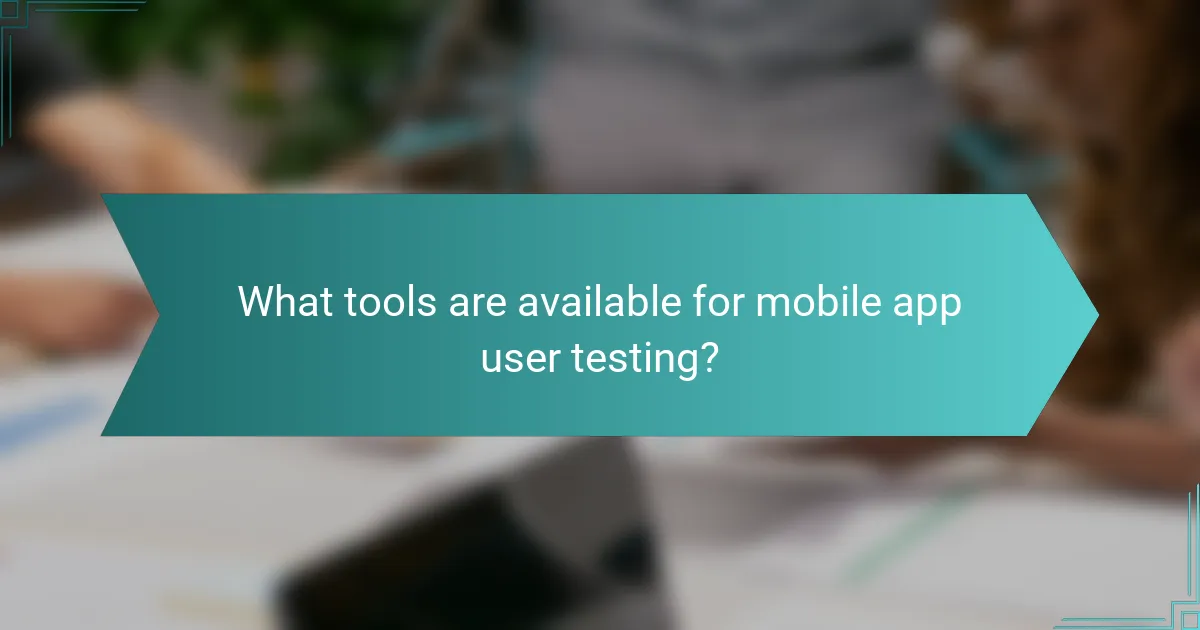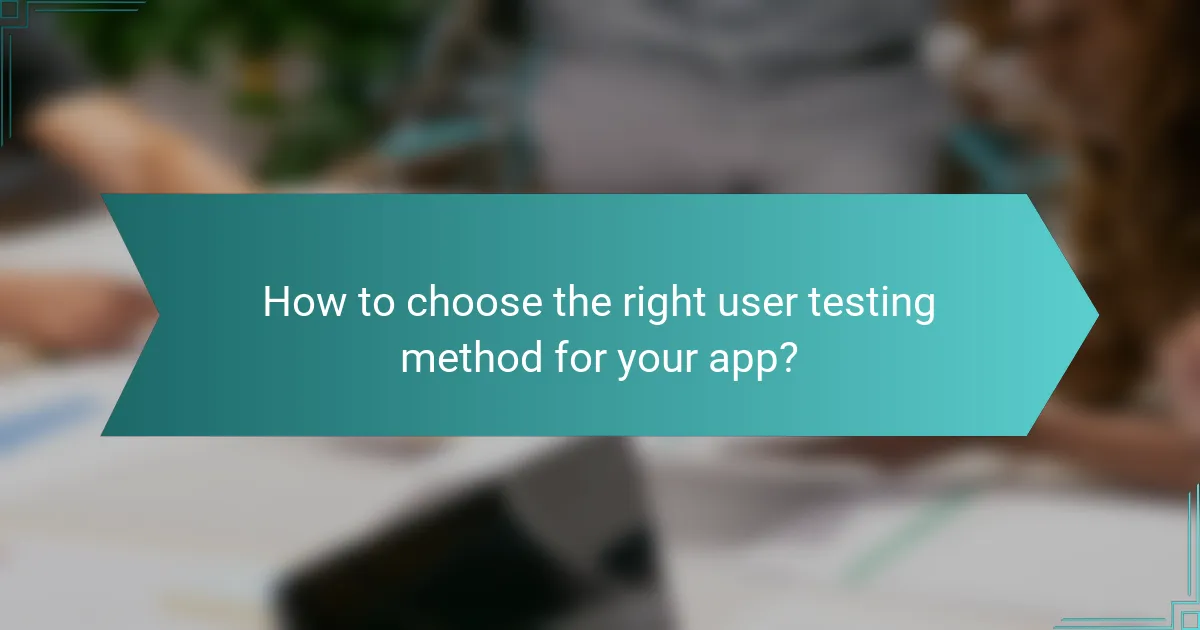Mobile app user testing is crucial for creating effective and engaging applications, employing methods such as remote usability testing, A/B testing, and focus groups to gather valuable user feedback. By analyzing this feedback, designers can make informed decisions that enhance user experience and satisfaction. Key metrics like user satisfaction scores and task completion rates further guide the iterative process, ensuring the app evolves to meet user needs effectively.

What are the best methods for mobile app user testing in Canada?
The best methods for mobile app user testing in Canada include remote usability testing, in-person user testing, A/B testing, focus groups, and surveys. Each method offers unique advantages and can be tailored to gather specific feedback from users, ensuring the app meets their needs and expectations.
Remote usability testing
Remote usability testing allows users to interact with the app from their own devices, providing insights into real-world usage. This method can be conducted through various platforms that record user interactions and feedback, making it convenient and cost-effective.
Consider using tools like UserTesting or Lookback, which facilitate remote sessions. Aim for a diverse group of participants to capture a wide range of experiences and preferences. Ensure that tasks are clear and relevant to the app’s primary functions.
In-person user testing
In-person user testing involves observing users as they interact with the app in a controlled environment. This method allows for immediate feedback and clarification of user thoughts, providing deeper insights into usability issues.
Set up sessions in locations convenient for participants, such as co-working spaces or community centers. Prepare specific tasks for users to complete, and encourage them to verbalize their thoughts during the process. This can reveal pain points that may not be apparent through remote testing.
A/B testing
A/B testing compares two or more versions of an app feature to determine which performs better. This method is effective for optimizing user interfaces and functionalities based on real user data.
To conduct A/B testing, define clear metrics for success, such as user engagement or conversion rates. Use tools like Optimizely or Google Optimize to manage the tests. Ensure that the sample size is large enough to yield statistically significant results, typically in the low hundreds to thousands of users.
Focus groups
Focus groups gather a small group of users to discuss their experiences and opinions about the app. This qualitative method can uncover user motivations and feelings that quantitative data might miss.
Recruit participants who represent your target audience and prepare open-ended questions to guide the discussion. Limit the group size to around 6-10 participants to ensure everyone can contribute. Take detailed notes or record sessions for later analysis.
Surveys and questionnaires
Surveys and questionnaires are effective for collecting quantitative data from a larger audience. They can assess user satisfaction, feature importance, and overall app usability.
Use platforms like SurveyMonkey or Google Forms to create and distribute surveys. Keep questions concise and focused, using a mix of multiple-choice and open-ended questions. Aim for a completion time of under 5 minutes to encourage participation, and consider offering incentives for responses.

How can feedback improve mobile app design?
Feedback is essential for enhancing mobile app design as it provides insights into user experiences and preferences. By systematically collecting and analyzing user feedback, designers can make informed decisions that align with user needs, leading to a more effective and engaging app.
Identifying user pain points
Identifying user pain points involves understanding where users encounter difficulties or frustrations while using the app. Common methods include usability testing, surveys, and direct user interviews. These approaches help pinpoint specific areas that require improvement, such as navigation issues or unclear features.
For example, if users frequently report confusion about how to access certain functionalities, this indicates a need for clearer design or better onboarding processes. Addressing these pain points can significantly enhance user satisfaction and retention.
Enhancing user experience
Enhancing user experience (UX) is achieved by integrating feedback into the design process. This can involve refining interface elements, improving loading times, or simplifying user flows based on user suggestions. Regularly updating the app based on user feedback ensures that it remains relevant and user-friendly.
For instance, if feedback indicates that users prefer a darker theme for nighttime use, implementing this feature can lead to increased user engagement. Prioritizing user experience fosters loyalty and encourages positive reviews, which are crucial for app visibility and success.
Validating design choices
Validating design choices is critical to ensure that the decisions made during the design process resonate with users. A/B testing is a popular method for comparing different design elements to see which version performs better. This data-driven approach allows designers to make adjustments based on actual user behavior rather than assumptions.
For example, testing two different button placements can reveal which layout leads to higher conversion rates. By validating design choices through user feedback, developers can confidently implement changes that enhance functionality and appeal.

What are the key metrics for evaluating user testing feedback?
Key metrics for evaluating user testing feedback include user satisfaction score, task completion rate, and time on task. These metrics help assess how effectively users interact with a mobile app and identify areas for improvement.
User satisfaction score
User satisfaction score measures how pleased users are with their experience using the app. This score is often gathered through surveys or feedback forms, typically using a scale from 1 to 5 or 1 to 10.
To effectively gauge satisfaction, focus on specific aspects such as usability, design, and functionality. A high satisfaction score indicates a positive user experience, while a low score highlights areas needing attention.
Task completion rate
The task completion rate indicates the percentage of users who successfully complete a specific task within the app. This metric is crucial for understanding usability and effectiveness.
To calculate this rate, divide the number of users who completed the task by the total number of users who attempted it. Aim for a completion rate above 80% to ensure that users can navigate the app effectively.
Time on task
Time on task measures how long it takes users to complete a specific action within the app. This metric helps identify potential usability issues or areas where users may struggle.
Shorter times generally indicate a more intuitive design, while longer times may suggest confusion or complexity. Aim for task completion times in the low single-digit minutes for optimal user experience.

What tools are available for mobile app user testing?
Several tools are available for mobile app user testing, each offering unique features to gather user feedback effectively. These tools help developers understand user behavior, identify usability issues, and refine their applications based on real user experiences.
Lookback
Lookback is a user research platform that enables live and recorded user testing sessions. It allows teams to observe users interacting with their mobile apps in real-time, providing insights into user behavior and preferences.
Key features include screen sharing, video recording, and the ability to conduct interviews. This tool is particularly useful for gathering qualitative data and understanding user motivations.
UserTesting
UserTesting is a widely-used platform that connects businesses with real users for feedback on their mobile apps. It offers a diverse panel of testers, allowing you to target specific demographics and gather insights from your intended audience.
The platform provides video recordings of user interactions along with written feedback, making it easier to analyze user experiences. UserTesting is ideal for both quick tests and in-depth studies, helping teams iterate effectively based on user input.
Optimal Workshop
Optimal Workshop focuses on usability testing and user research, offering tools for card sorting, tree testing, and first-click testing. These methods help assess the information architecture and navigation of mobile apps.
By using Optimal Workshop, teams can gain insights into how users categorize information and navigate through their apps. This tool is beneficial for improving user experience and ensuring that the app’s structure aligns with user expectations.

What are the best practices for iterating based on user feedback?
Iterating based on user feedback involves systematically analyzing input from users to enhance the mobile app experience. Best practices include prioritizing feedback, implementing changes in sprints, and conducting follow-up tests to ensure improvements meet user needs.
Prioritizing feedback
Prioritizing feedback is crucial for effective iteration. Start by categorizing feedback into themes such as usability, functionality, and design. Use methods like the MoSCoW technique (Must have, Should have, Could have, Won’t have) to determine which issues to address first based on user impact and development resources.
Consider the frequency and severity of reported issues. If many users highlight a particular problem, it should be prioritized over less common feedback. This approach ensures that the most critical user needs are addressed promptly, enhancing overall satisfaction.
Implementing changes in sprints
Implementing changes in sprints allows for rapid development cycles, enabling teams to adapt quickly to user feedback. A typical sprint lasts one to two weeks, during which specific feedback items are addressed. This iterative process helps maintain momentum and keeps the development team focused on user-centered improvements.
During each sprint, ensure that the team reviews the prioritized feedback and selects a manageable number of changes to implement. This prevents overwhelm and allows for thorough testing of each modification before moving on to the next set of adjustments.
Conducting follow-up tests
Conducting follow-up tests is essential to validate the effectiveness of implemented changes. After each sprint, engage users in testing the new features or improvements to gather fresh feedback. This can be done through usability testing sessions, surveys, or beta releases to a select group of users.
Analyze the results of follow-up tests to determine if the changes have resolved previous issues and improved user satisfaction. Continuous testing and feedback loops create a cycle of ongoing improvement, ensuring the app evolves in line with user expectations and needs.

How to choose the right user testing method for your app?
Selecting the right user testing method for your mobile app involves understanding your goals, the stage of development, and the type of feedback you need. Consider factors such as budget, timeline, and the specific insights you aim to gather from users.
Types of user testing methods
User testing methods can be broadly categorized into qualitative and quantitative approaches. Qualitative methods, like interviews and usability testing, provide in-depth insights into user behavior and preferences. Quantitative methods, such as surveys and analytics, offer measurable data that can help identify trends and patterns.
Common qualitative methods include moderated usability tests, where users interact with your app while being observed, and unmoderated tests, which allow users to complete tasks independently. Quantitative methods often involve A/B testing, where two versions of an app are compared to see which performs better based on user interactions.
Factors to consider when choosing a method
When selecting a user testing method, consider your objectives. If you need detailed feedback on user experience, qualitative methods are more suitable. For assessing overall app performance or user engagement, quantitative methods can provide valuable metrics.
Budget constraints also play a critical role. Qualitative testing can be more resource-intensive due to the need for facilitation and analysis, while quantitative methods can often be conducted at a lower cost using online tools. Additionally, the stage of your app’s development will influence your choice; early-stage apps may benefit more from qualitative insights, whereas later stages might require quantitative validation.
Common pitfalls to avoid
One common pitfall is neglecting to define clear objectives before testing. Without specific goals, it can be challenging to interpret results effectively. Another mistake is failing to involve a diverse group of users, which can lead to biased feedback that doesn’t represent your target audience.
Additionally, avoid over-relying on a single method. Combining qualitative and quantitative approaches can provide a more comprehensive understanding of user needs. Lastly, ensure that you act on the feedback received; failing to iterate based on user insights can hinder your app’s success.










